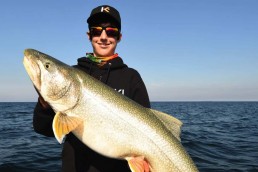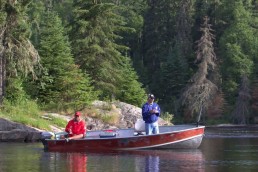Trolling Time Out: For hottest lake trout bites in summer, think like an ice angler and jig
When fishing typical Canadian Shield lakes, what’s the most efficient, effective way to catch lake trout during the summer? The answer is vertical jigging, the same method you use through the ice now, complete with the identical lines, lures and presentations.
Now, I know this is going to raise some eyebrows. And it’s not meant to diminish the advantages of controlled-depth fishing with downriggers or trolling with wire line, planer boards and segmented leadcore. In fact, I’ve used a downrigger to catch my two biggest lake trout: twin 40-pound leviathans. And, I love the precision made possible with metal line.
But downrigging requires a hefty upfront investment in a boat, motor, downriggers, sonar and GPS, not to mention specialized rods and reels. Ditto for leadcore and wire line. On the flip side, you can vertical jig for lake trout with your favorite bass and walleye tackle, etc., and it doesn’t matter what you fish from: canoe, kayak, car topper, bass boat or family runabout.
So, do I have downriggers on my boat? You bet. And I’d never give up my line-counting wire and leadcore reels. But many—dare I say most—summer days I can catch as many or more lake trout simply jigging a 4-inch white tube jig, a soft plastic swimbait or lipless crankbait on my bass and walleye rods. And you can, too.
Where to find Lakers
Vertical jigging is perfectly suited for catching lake trout in the summer because the fish concentrate in and around well-defined locations that are easy to find. Start by identifying any bottom structure that’s solid, firm and different from its surroundings such as long, protruding underwater points, boulder-strewn reefs, sunken shoals and isolated rock piles.
Next, add in a good helping of “confined open space.” It may sound contradictory, but confined open space is how I describe the main-lake area immediately adjacent to the structure—its zone of influence. Essentially, the structure serves as the rendezvous point for lake trout that cruise the area, especially the ones suspended off the edges in that confined open water.
After finding suitable bottom structure with confined open space, most anglers stop searching and start fishing. But you can take your detective work one step further and find the sweet spots on the spot—pinch points. These are the canyons, valleys, gullies, box draws and ambush sites that lake trout use to corral, confuse and consume baitfish.
Wild West fishing
Think of the classic Hollywood “western” with cowboys chasing their foes into the dead end of a high-walled canyon, with no chance of escape. That’s precisely how lake trout use structure, confined open space and pinch points in Canadian Shield lakes to funnel, herd and corral schools of pelagic, open-water roaming ciscoes, smelt and shiners.
After trapping their prey, the lake trout feed on the confused baitfish, often creating feeding frenzies. And that’s one of the reasons why I call them pinch points—they’re so good that when you find them and start fishing you have to pinch yourself to make sure it’s not a dream.
What to fish
Once you know where to find open-water lake trout, catching them is a piece of cake. It’s often no more difficult than dropping a tube jig, swimbait, grub or lipless crankbait over the side of the boat. These are the very same lures you would use for lakers in the winter or to catch walleye, bass and northern pike in the summer. If you want to pare back your tackle selection to the absolute bare minimum, you could do worse than fishing the entire season with a 4-inch White, scented Berkley Power, Mr. Twister Exude or Trigger-X tube over a 1/4- to 3/8-ounce cylindrical lead head.
Complete your setup with a walleye/bass rig—a 7- to 7 1/2-foot-long medium- to medium-heavy-action spinning or baitcasting rod and a reel spooled with 10-pound-test monofilament or fluorocarbon or 14-pound-test braided line. I prefer braid, tipped with 2 feet of flouro. Now you’re ready to cast the lure or drop it over the side of the boat and let it fall until it’s on the lake bottom or below the thermocline.
If you don’t own a sonar unit, don’t worry. As a general rule, you can assume the thermocline is approximately 30 feet down in June and 35 to 40 feet down the rest of the summer. Many biologists refer to the thermocline as the “ciscoe layer,” which tells you all you need to know about where the trout’s food is located, and, is why lakers suspend in the colder water just below it (see “Summer Lake Stratification Zones” diagram).
How far down should you probe? As a general rule, most lake trout anglers assume that in deep water the fish are always on or near the bottom of a lake. But this is simply not true, especially when the baitfish are suspended much higher in the water column, relating to the bottom of the plankton-rich thermocline. By August, oxygen levels near the bottom of a lake are often depleted because of the decomposition process. This forces lake trout to suspend in the water column and relate even more strongly to the zone just below the thermocline.
I like to concentrate my vertical jigging in the 10-foot zone below the base of the thermocline, regardless of the overall depth. In other words, if the base of the thermocline is 35 feet down, I’ll spend most of my time jigging 35 to 45 feet below the boat, even if the water is 80 feet or more deep.
Even if the lake trout are relating to slightly deeper water, keep in mind that one of the primary characteristics of lake trout lakes is gin-clear water. Trust me—these sharp-eyed fish will have no difficulty seeing your lure above them. You can observe this on days when the fish are exceedingly active. They appear on your sonar screen as those telltale arcs. The second your lure enters the water, you’ll see the trout start swimming up to pounce on the bait as it crashes through the thermocline. That’s the ideal scenario. Other times you’ll have to drop your lure into the zone and begin a steady, 3- to 4-foot lift-pause or fall-pause jigging motion to attract the fish. Use a tube jig, a soft plastic paddle-tail swimbait or lipless crankbait such as a Live Target Shad or Rapala Clackin’ Rap. Eventually—and quite suddenly—you’ll see a lake trout zoom onto the screen, chasing after the lure. When that happens, if the fish doesn’t immediately devour the bait, start reeling it away as though it were a terrified ciscoe seeing its life flash before its eyes. As far as the lake trout is concerned, your lure’s days are going to be over in a split second.
And there you have it—the most efficient, effective and effortless way to catch lake trout throughout the summer months across Canada’s vast Shield country: Plan now to be fish there in summer as if it were still winter.
MWO
SHARE THIS POST
You may also like...
Did you enjoy this post?
You can be among the first to get the latest info on where to go, what to use and how to use it!
Gord Pyzer
Hall of Fame fisherman, fisheries scientist, and legendary fishing writer Gord Pyzer has a Master’s in Resource Management, spent 30-plus years with Ontario Ministry of Natural Resources, and is a pioneer in modern muskie management. Pyzer is Fishing Editor for Outdoor Canada magazine, and now a regular contributor to MidWest Outdoors.



